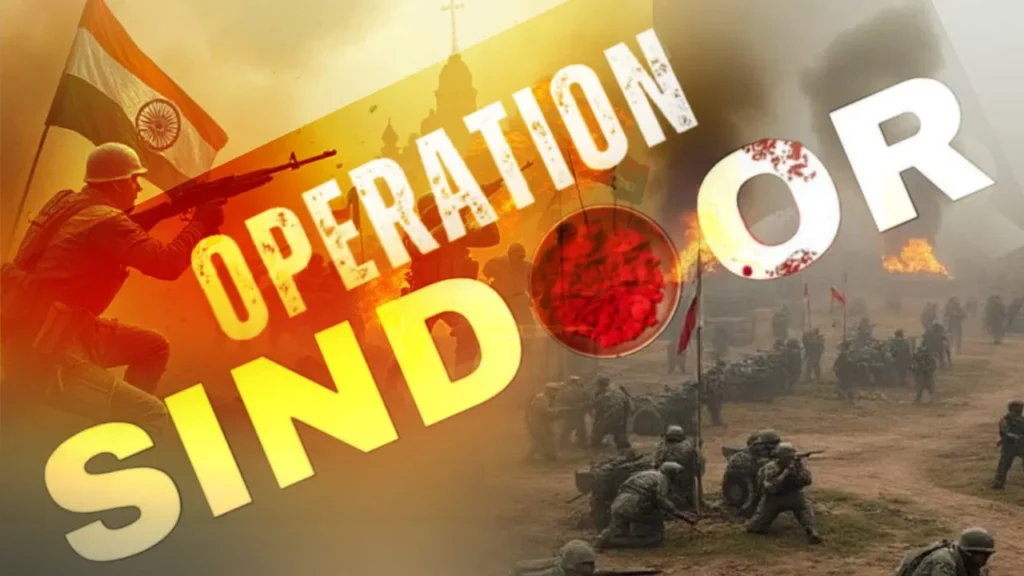Operation Sindoor: भारत का पहलगाम आतंकवादी हमले का करारा जवाब
22 अप्रैल को जम्मू और कश्मीर के पहलगाम में एक दुखद आतंकवादी हमला हुआ, जिसमें 26 निर्दोष पर्यटकों की जान चली गई। चौदह दिन बाद, भारत ने इस आतंकवादी हमले के खिलाफ कार्रवाई की। इन पीड़ितों में कई नई शादीशुदा महिलाएं भी थीं, जिनके सपने और जीवन बहुत जल्द तबाह हो गए।
इस दिल दहला देने वाली घटना का जवाब देने के लिए भारत ने “ऑपरेशन सिंदूर” नामक एक शक्तिशाली सैन्य अभियान लॉन्च किया — एक मिशन जो पीड़ितों को न्याय दिलाने और शत्रुओं को एक स्पष्ट संदेश देने के लिए था।

भारत ने लिया बदला: ऑपरेशन सिंदूर की शुरुआत
पहलगाम में हुए इस भयावह हमले के बाद भारतीय सरकार ने आतंकवाद के खिलाफ कठोर कदम उठाने का वचन लिया। यह वचन बुधवार को दोपहर 1:30 बजे पूरा हुआ, जब भारतीय सशस्त्र बलों ने ऑपरेशन सिंदूर शुरू किया।
इस अभियान के तहत भारतीय बलों ने पाकिस्तान और PoK में प्रवेश किया और 9 प्रमुख आतंकवादी शिविरों को निशाना बनाया। आधिकारिक रिपोर्ट्स के अनुसार, लगभग 70 आतंकवादियों, जिनमें लश्कर के हैंडलर भी शामिल थे, को खत्म कर दिया गया। यह संख्या और बढ़ सकती है क्योंकि और विवरण सामने आ रहे हैं।
“ऑपरेशन सिंदूर” नाम किसने रखा?
इस ऑपरेशन का नाम सुनकर हर किसी के मन में एक सवाल था — “ऑपरेशन सिंदूर” नाम किसने रखा? इस मिशन का नाम स्वयं प्रधानमंत्री नरेंद्र मोदी ने चुना था।
उन्होने यह नाम सिर्फ एक रणनीतिक नामकरण के रूप में नहीं, बल्कि उन महिलाओं को एक भावनात्मक श्रद्धांजलि देने के लिए चुना, जिन्होंने पहलगाम आतंकी हमले में अपने पति खो दिए थे। “सिंदूर” शब्द उस गहरे दुख और देश के न्याय के संकल्प को दर्शाता है।
“ऑपरेशन सिंदूर” नाम क्यों रखा गया?
“सिंदूर” (लाल रंग का पाउडर) भारतीय परंपरा में एक महिला की वैवाहिक स्थिति को दर्शाता है। पहलगाम हमले के दौरान, कई शादीशुदा महिलाएं अपने पतियों को खो बैठीं, जिनकी शादी को कुछ ही दिन या महीने हुए थे। आतंकवाद ने उनका “सिंदूर” छीन लिया।
यह ऑपरेशन उन महिलाओं को श्रद्धांजलि और न्याय देने का एक तरीका है — उनके नुकसान का अर्थ देने के लिए और यह दिखाने के लिए कि भारत ऐसी क्रूरता को कभी नहीं भूलने और माफ करने वाला नहीं है।
“जब न्याय की पुकार खून से सनी हो, तब ऑपरेशन सिंदूर जैसे निर्णय इतिहास में लिखे जाते हैं।”
हमले में क्या हुआ?
भारतीय सेना, वायुसेना और नौसेना ने पाकिस्तान और पाकिस्तान-नियंत्रित कश्मीर (PoK) में गहरी घुसपैठ करते हुए 9 आतंकवादी ठिकानों को नष्ट कर दिया। इस हवाई हमले में भारी तबाही मचाई गई और 70 आतंकवादी मारे गए। पाकिस्तान के प्रधानमंत्री ने इसे युद्ध की कार्रवाई करार देते हुए प्रतिशोध की धमकी दी है।
इसके जवाब में पाकिस्तान ने अपने हवाई क्षेत्र को 48 घंटों के लिए बंद कर दिया है, जो इस स्थिति की गंभीरता को दर्शाता है।
ऑपरेशन सिंदूर की सफलता के बाद, उच्च स्तरीय बैठकें और अहम बातचीत
ऑपरेशन सिंदूर के सफलतापूर्वक अंजाम दिए जाने के बाद, रक्षा मंत्री राजनाथ सिंह ने देर रात थल सेना, वायु सेना और नौसेना प्रमुखों के साथ बैठक की और पूरी स्थिति की विस्तृत जानकारी ली।
भारत के राष्ट्रीय सुरक्षा सलाहकार (NSA) अजीत डोभाल ने अमेरिका के NSA और विदेश मंत्री मार्को रुबियो से बातचीत की और ऑपरेशन तथा क्षेत्रीय सुरक्षा पर चर्चा की।
भारतीय सेना ने इस मिशन से जुड़ी विस्तृत जानकारी साझा की है, जिससे इसके प्रभाव और सफलता की पुष्टि होती है।
भारत ने इन 9 आतंकियों के ठिकानों पर किया सीधा हमला: जानिए ऑपरेशन सिंदूर के टारगेट्स
ऑपरेशन सिंदूर के तहत भारत ने अपने साहसिक और निर्णायक सैन्य कार्रवाई के रूप में पाकिस्तान और पाकिस्तान अधिकृत कश्मीर (PoK) में स्थित नौ उच्च-मूल्य वाले आतंकवादी ठिकानों पर सटीक हमले किए। ये सभी ठिकाने कुख्यात आतंकी संगठनों — जैश-ए-मोहम्मद (JeM), लश्कर-ए-तैयबा (LeT) और हिज्बुल मुजाहिदीन (HM) — द्वारा संचालित किए जा रहे थे।
- मरकज़ सुब्हान अल्लाह, बहावलपुर – जैश-ए-मोहम्मद (JeM) का ठिकाना
- मरकज़ तैयबा, मुरिदके – लश्कर-ए-तैयबा (LeT) का मुख्यालय
- सरजल, टेहड़ा कलां – जैश-ए-मोहम्मद का अड्डा
- महमूना जोया, सियालकोट – हिज्बुल मुजाहिदीन (HM) का ठिकाना
- मरकज़ अहले हदीस, बरनाला – लश्कर-ए-तैयबा का अड्डा
- मरकज़ अब्बास, कोटली – जैश-ए-मोहम्मद का केंद्र
- मस्कर रहील शहीद, कोटली – हिज्बुल मुजाहिदीन का प्रशिक्षण शिविर
- शवाई नाला कैंप, मुजफ्फराबाद – लश्कर-ए-तैयबा का आतंकी शिविर
- सैयदना बिलाल कैंप, मुजफ्फराबाद – जैश-ए-मोहम्मद का संचालन केंद्र
निष्कर्ष:
ऑपरेशन सिंदूर सिर्फ एक सैन्य मिशन नहीं है — यह आतंकवाद के खिलाफ एक भावनात्मक और प्रतीकात्मक जवाब है। यह दिखाता है कि भारत अपनी जनता पर हुए किसी भी हमले के खिलाफ मजबूत खड़ा है, विशेष रूप से जब निर्दोष जानें और नागरिकों की गरिमा दांव पर हो।
यह ऑपरेशन दुनिया को एक स्पष्ट संदेश देता है: भारत वापस लड़ेगा — ताकत, रणनीति और दिल से।
What is the Operation Sindoor? in English

Operation Sindoor: India’s Bold Reply to the Pahalgam Terror Attack
On 22nd April, a tragic terrorist attack took place in Pahalgam, Jammu & Kashmir, where 26 innocent tourists lost their lives. 14 days later, India took action against this act of terrorism. Among the victims were several newly married women, whose dreams and lives were shattered too soon.
In response to this heartbreaking incident, India launched a powerful military operation named “Operation Sindoor” — a mission to bring justice to the victims and a clear message to the enemies.
India Takes Revenge: Operation Sindoor Begins
After the deadly attack in Pahalgam, the Indian government vowed to take a strong stand against terrorism. That promise was fulfilled on Wednesday at 1:30 PM, when the Indian Armed Forces launched Operation Sindoor.
As part of this operation, Indian forces crossed into Pakistan and PoK, targeting 9 major terrorist camps. As per official reports, around 70 terrorists, including Lashkar handlers, were eliminated. This number may increase as further details emerge.
Who named it “Operation Sindoor”?
The name “Operation Sindoor” sparked a question in everyone’s mind — who chose such an emotional and powerful title? It was none other than Prime Minister Narendra Modi who personally named the mission.
He didn’t choose the name just for strategy, but as a heartfelt tribute to the women who lost their husbands in the Pahalgam terror attack. The word “Sindoor” symbolizes not just their personal loss, but also the nation’s promise to deliver justice and stand strong against cruelty.
Why the Name “Operation Sindoor”?
The word “Sindoor” (vermilion) symbolizes the marital status of a woman in Indian tradition. During the Pahalgam attack, many married women lost their husbands, some just days or months after marriage. Their “sindoor” was wiped away by terrorism.
This operation is India’s tribute and justice for those women — a way to give meaning to their loss and to show that India will never forget or forgive such brutality.
“When the cry for justice is soaked in blood, decisions like Operation Sindoor are written in history.”
What Happened in the Strike?
Indian Army, Air Force and Navy destroyed 9 terrorist hideouts deep inside Pakistan and Pakistan-occupied Kashmir (PoK). The airstrike caused massive damage, and 70 terrorists were killed. Pakistan’s Prime Minister has responded by calling this an act of war and has threatened retaliation.
In response, Pakistan has shut down its airspace for 48 hours, signaling the seriousness of the situation.
After Operation Sindoor’s Success, High-Level Meetings and Key Talks
Following the successful execution of Operation Sindoor, India’s Defence Minister Rajnath Singh held a late-night meeting with the Chiefs of the Army, Air Force, and Navy. He reviewed the entire situation and was briefed on every critical detail of the mission.
Meanwhile, India’s National Security Advisor Ajit Doval spoke with US NSA and Secretary of State Marco Rubio, discussing both the operation and the broader regional security concerns.
The Indian Armed Forces have also released a detailed report on the mission, confirming the effectiveness and strategic success of Operation Sindoor.
India Strikes 9 Key Terror Bases in Operation Sindoor: Full List of Targets Revealed
As part of its bold and decisive military response under Operation Sindoor, India launched precision strikes on nine high-value terror camps located in Pakistan and Pakistan-occupied Kashmir (PoK). These camps were known to be operated by major terror groups such as Jaish-e-Mohammed (JeM), Lashkar-e-Taiba (LeT), and Hizbul Mujahideen (HM).
Here are the 9 terror bases targeted by Indian forces:
- Markaz Subhan Allah, Bahawalpur – A major base of Jaish-e-Mohammed (JeM)
- Markaz Tayyaba, Muridke – The central headquarters of Lashkar-e-Taiba (LeT)
- Sarjal, Tehra Kalan – An active operational site of Jaish-e-Mohammed
- Mahmuna Zoya, Sialkot – A known hideout for Hizbul Mujahideen (HM)
- Markaz Ahle Hadees, Barnala – Another strategic camp of Lashkar-e-Taiba
- Markaz Abbas, Kotli – A key center for JeM’s core operations
- Maskar Raheel Shaheed, Kotli – A training ground of Hizbul Mujahideen
- Shawai Nala Camp, Muzaffarabad – A well-established LeT terrorist base
- Sayyadna Bilal Camp, Muzaffarabad – A major control and command hub for Jaish-e-Mohammed
In Conclusion, Operation Sindoor is not just a military mission — it’s an emotional and symbolic response to terrorism. It shows that India stands strong against any attack on its people, especially when innocent lives and the dignity of its citizens are at stake.This operation is a clear message to the world: India will fight back — with strength, strategy, and heart.

